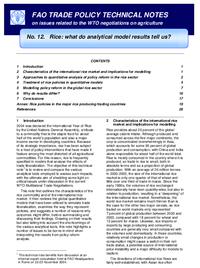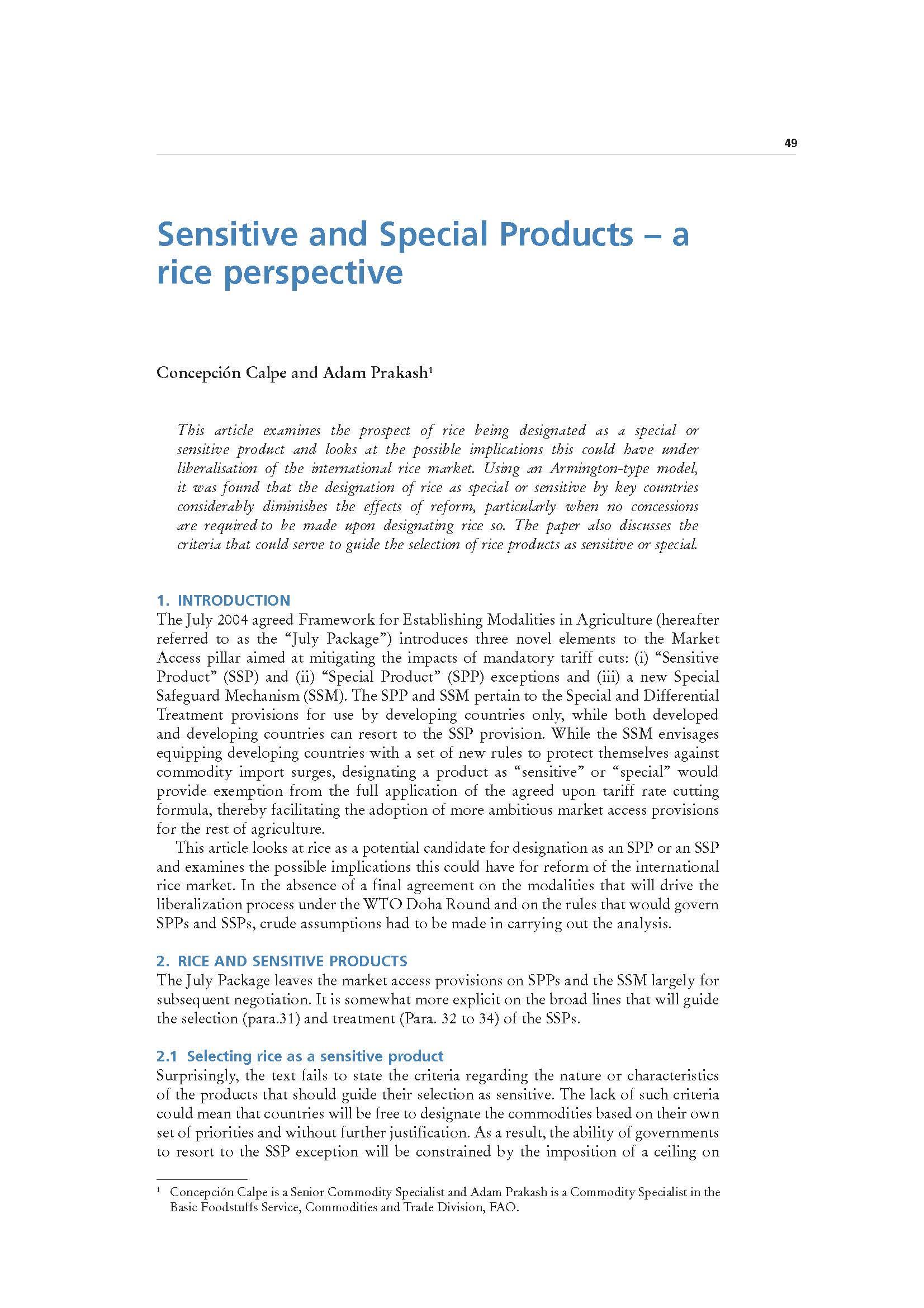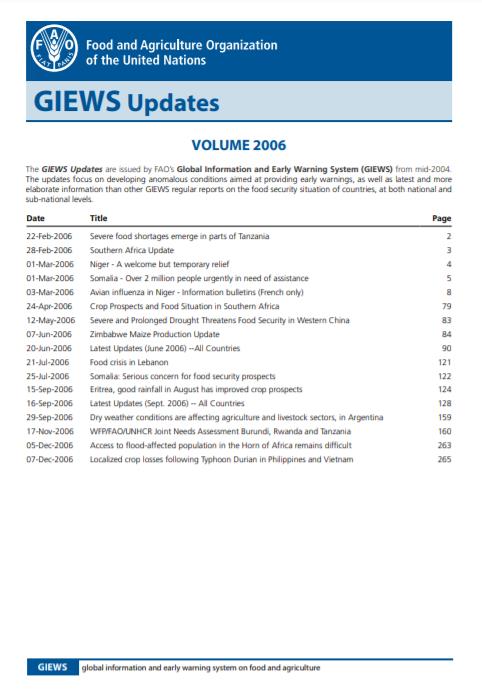
GIEWS Updates - Volume 2006
22/02/2006
The GIEWS Updates are issued by FAO’s Global Information and Early Warning System (GIEWS) from mid-2004. The updates focus on developing anomalous conditions aimed at providing early warnings, as well as latest and more elaborate information than other GIEWS regular reports on the food security situation of countries, at both national and sub-national levels.
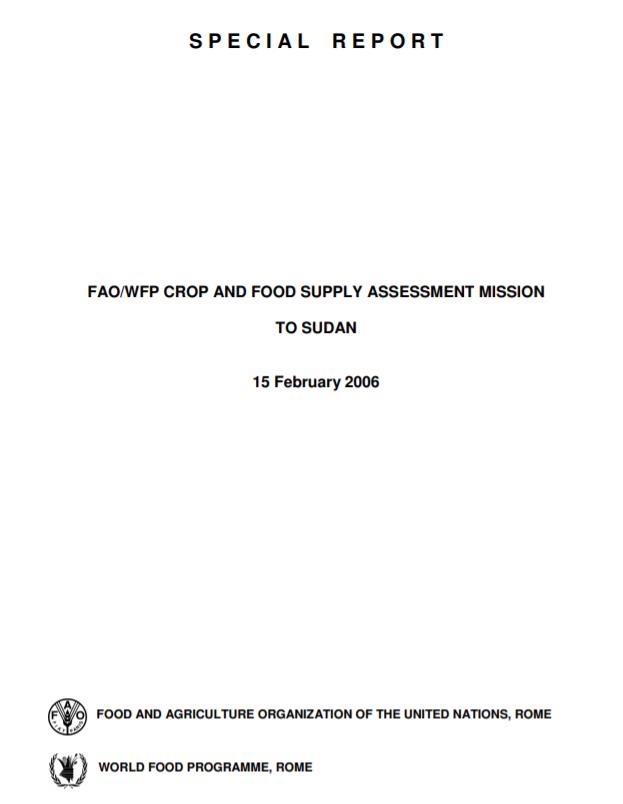
Special Report - FAO/WFP Crop and Food Supply Assessment Mission to Sudan - 15 February 2006
16/02/2006
An FAO/WFP Crop and Food Supply Assessment Mission visited southern Sudan from 8 to 27 October 2005 and northern Sudan from 12 November to 6 December 2005 in order to assess the current season’s cereal production, forecast wheat production from areas prepared for planting, and estimate cereal import requirements for the marketing year 2005/06 (November-October). The Mission in both northern and southern Sudan received the full cooperation of the Federal Ministry of Agriculture Humanitarian Aid Commission (HAC), Sudan Relief and Rehabilitation Commission (SRRC) and South Sudan Centre for Statistic and Evaluation (SSCSE), all assigned senior members of staff to accompany it. The Mission was accompanied by EC observers and benefited from a wide range of discussions with both national and international stakeholders.
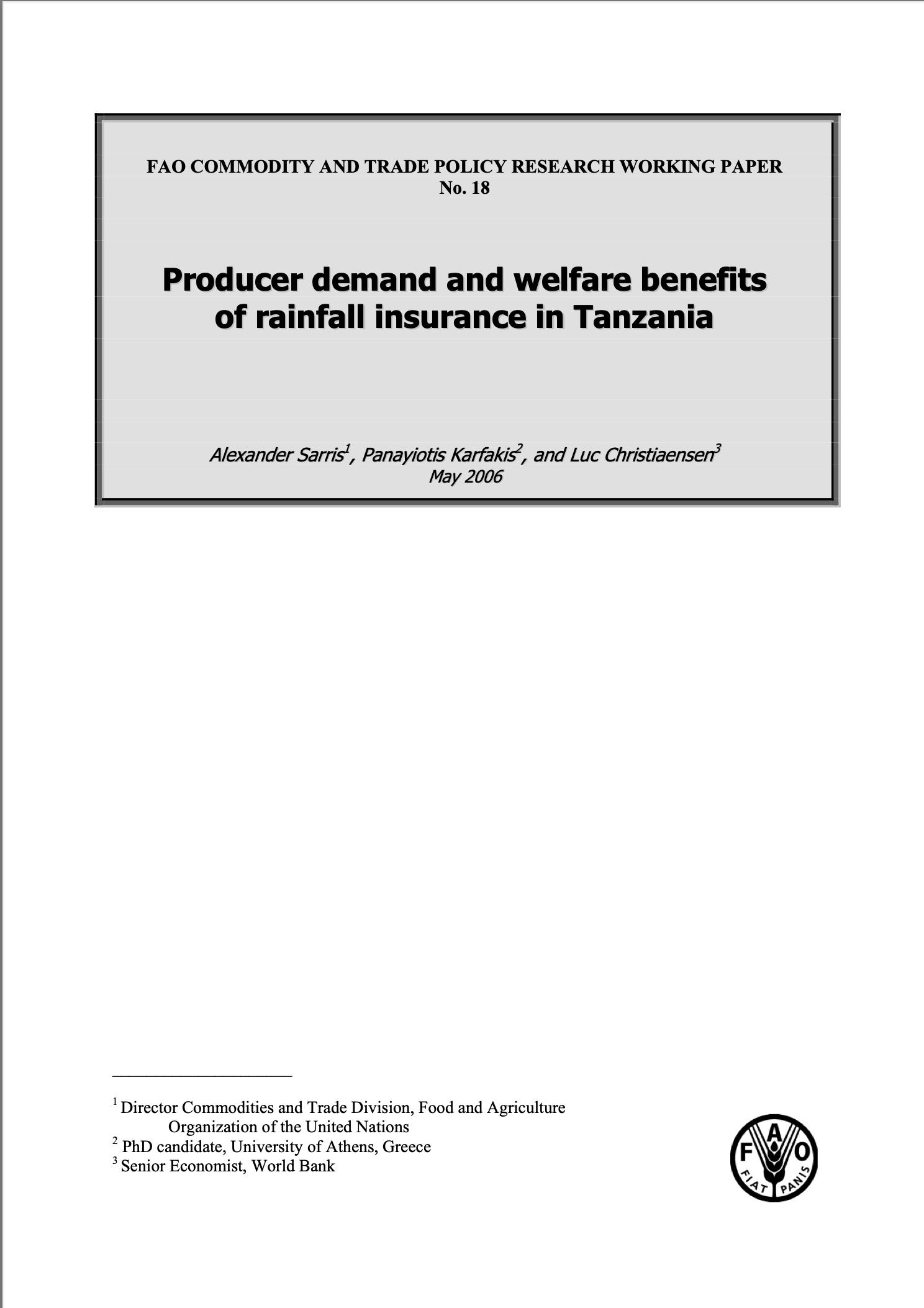
Producer demand and welfare benefits of rainfall insurance in Tanzania
01/01/2006
This paper explores empirically the issue of the demand, namely the willingness to pay (WTP), for rainfall-based insurance, in the context of a poor agrarian economy, with rural households significantly dependent on agricultural commodity risks. Using data from recent household surveys in the Kilimanjaro and Ruvuma regions of the United Republic of Tanzania, both important agricultural producing regions, the paper ascertains the nature of the weather related risks faced by smallholder growers in the context of their overall risk environment. It then estimates their desirability for weather- based income insurance as well as their demand for it by utilizing contingent valuation (CV) techniques. The results indicate that producer households are affected by a variety of shocks, of which weather related ones are very important. The paper estimates the demand for weather-based crop insurance in each of the two regions, and indicates that there seem to be considerable welfare benefits (net of costs) for such insurance, but differentiated according to regional rainfall instability, as well as producer incomes.
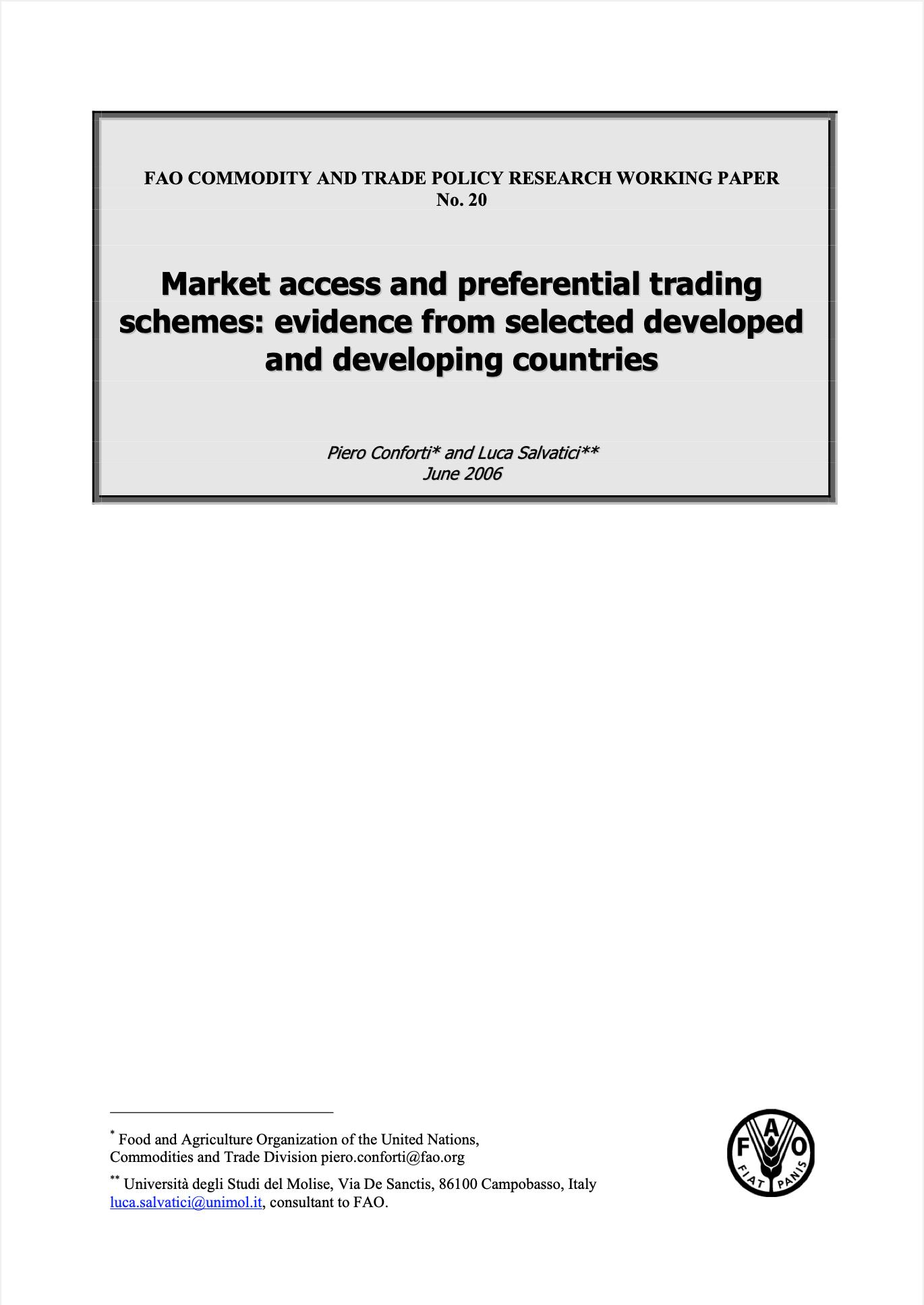
Market access and preferential trading schemes: evidence from selected developed and developing countries
01/01/2006
This report is aimed at analyzing the degree of protection faced by exporters in the EU, Japan, the United States, China, India and Brazil, and at identifying the contribution of product groups to the observed degree of market access. Data on the level of applied trade barriers provided by the MAcMap database is employed to compute Mercantilistic Trade Restrictiveness Indexes (MTRIs) on the basis of bilateral trade flows generated within a general equilibrium model framework. Results indicate that notwithstanding the rhetoric on trade preferences, developing country exporters appear to be still substantially restricted in their trade with some of the major developed country markets, such as the EU, Japan and the United States. Also, the three developing countries involved however impose significant restrictions on the access to their markets.
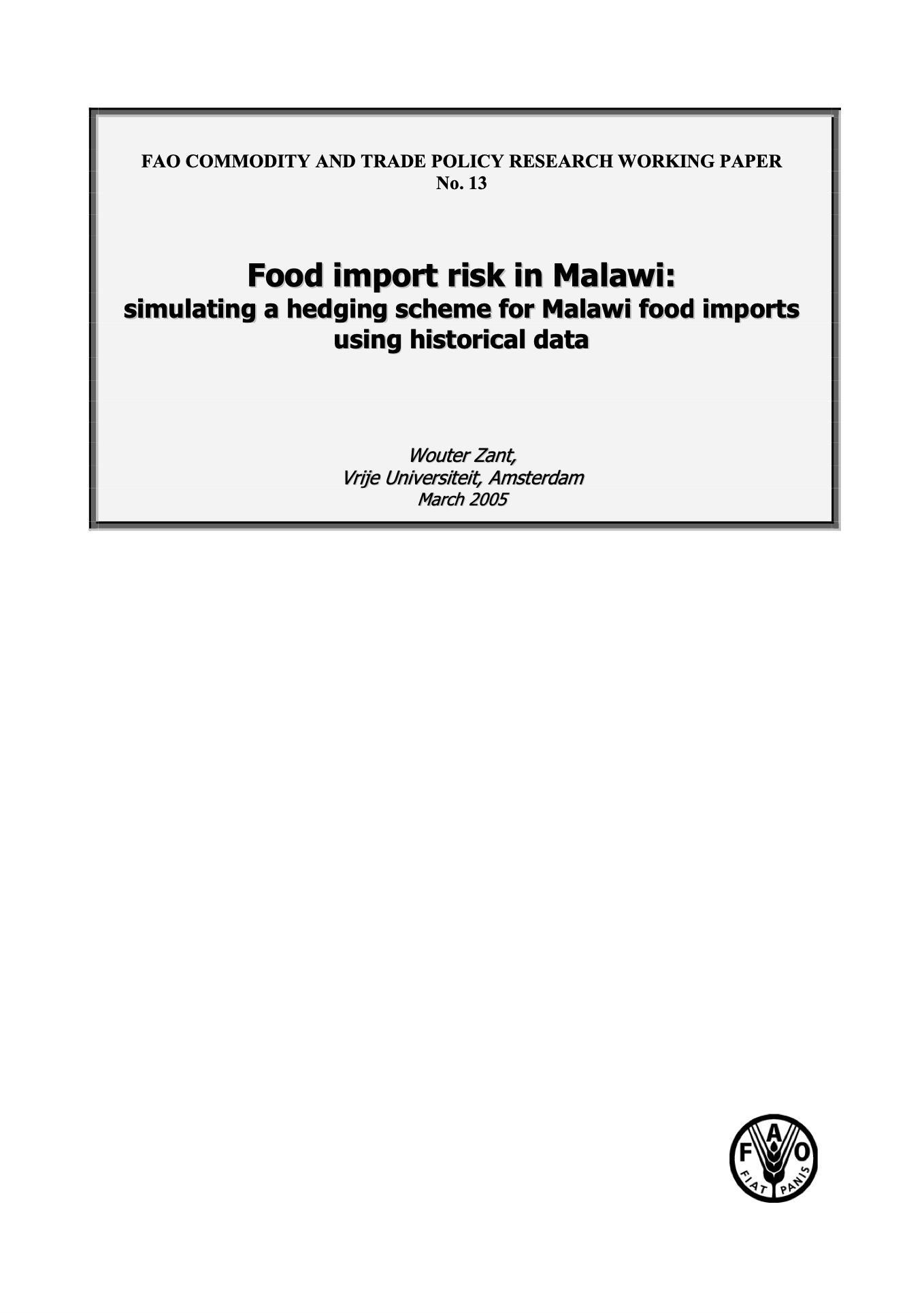
Food import risk in Malawi: simulating a hedging scheme for Malawi food imports using historical data
01/01/2006
During the 1980s and 1990s least developed countries (LDCs) encountered increasing difficulties in maintaining national food security. By the turn of the century commercial food import bills reached unprecedented heights in terms of domestic food consumption. The already precarious state of food security has been aggravated by occasional “spikes” in food import prices. Additionally, food aid has been reduced substantially by the donor community. The combination of these three developments - declines in food aid, increased commercial food imports and occasional “spikes” in food import prices - have caused a significant increase in the vulnerability of these countries. These circumstances have motivated a further and intensified investigation of policy instruments that can reduce the impact of volatile food import prices. The use of financial derivatives as instruments to hedge risks particularly deserves further exploration since these instruments are possibly cheap and do not distort physical markets. An integral part of this study is the exploration of ways in which the use of such instruments may be embedded in existing food import marketing and financial arrangements. While food import risks have not been a large part of the recent policy debate, it is likely that the increase in the LDCs’ food import bill and the increasing difficulties of LDCs to meet their food security requirements will become a major issue in the near and medium term future.
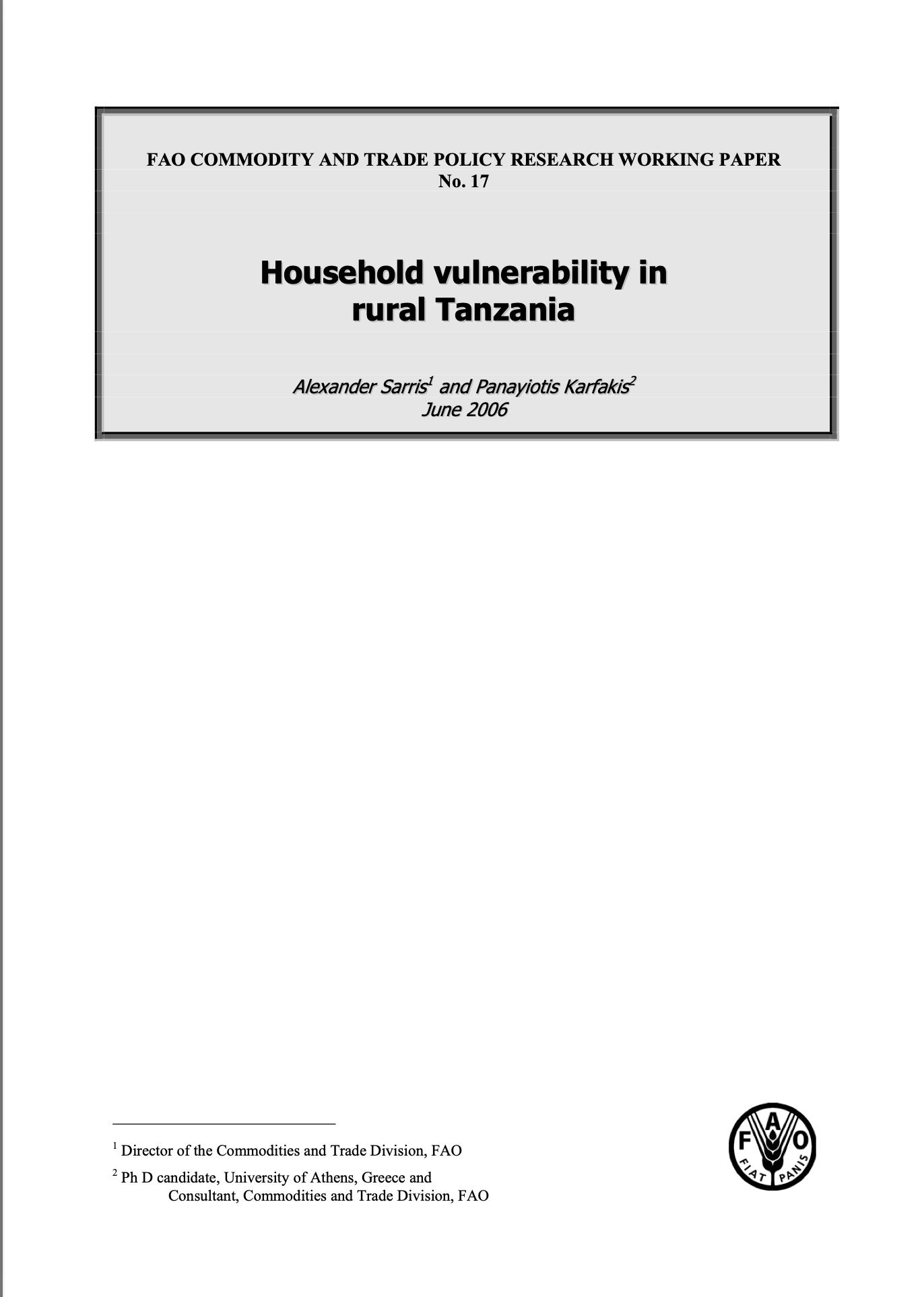
Household vulnerability in rural Tanzania
01/01/2006
This paper develops a measure of rural household vulnerability that combines existing approaches to estimating idiosyncratic risks with an approach to measuring covariate risk arising from crop production. The methodology is applied to rural households in Tanzania, using household surveys in two export crop producing regions. The results suggest that covariate risk arising from crop production faced by rural households is substantial and increases with farm size. Consumption is estimated to depend strongly on crop income, the variability of which induces considerable overall consumption risk. Overall, covariate risk is found to constitute smaller shares of total consumption risk in the wealthier region, but a dominant share in the poorer region. The share of covariate risk in total household consumption risk is found to be larger among the poor. Vulnerability is quite different between the two regions, with rural households in the poorer region exhibiting considerably higher vulnerability. Vulnerability in the poorer region is found to be larger than poverty incidence.

Threshold cointegration in the sugar-ethanol-oil price system in Brazil: evidence from nonlinear vector error correction models
01/01/2006
In this paper, the possibility of nonlinear dynamic adjustment in the sugar-ethanol-oil nexus in Brazil is examined. Threshold vector error correction models are employed to test for linearity in the adjustment of prices of sugar and oil, ethanol and oil and ethanol and sugar. Strong evidence of threshold type nonlinearity is found. The results suggest that sugar and oil and ethanol and oil prices are characterised by discrete threshold behaviour, whereas sugar and ethanol can be thought of as being linearly cointegrated. Threshold estimates suggest that sugar prices adjust rapidly to a long run equilibrium, determined by oil prices, in an asymmetric manner, when disequilibria are negative. The dynamic adjustment of ethanol prices is faster when the oil-ethanol price spread widens and ethanol prices are below a critical threshold. Both sugar and ethanol prices are found to be determined by oil prices and no evidence for a causal relationship that runs from oil to ethanol to sugar is found.
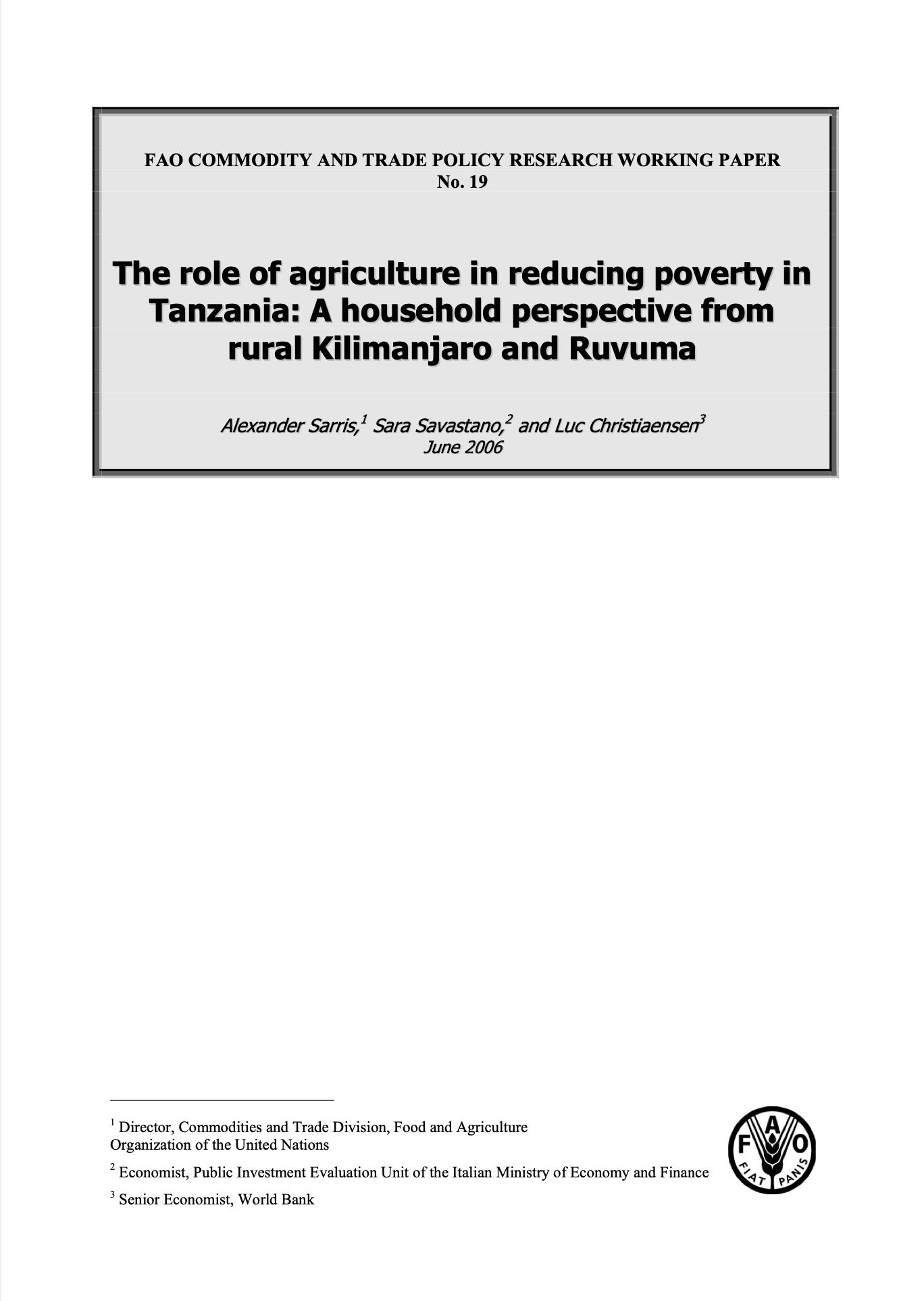
The role of agriculture in reducing poverty in Tanzania: A household perspective from rural Kilimanjaro and Ruvuma
01/01/2006
This paper explores how farm productivity affects poverty, and how various factor market constraints affect farm productivity. The empirical analysis draws on representative surveys of farm households in Kilimanjaro and Ruvuma, two cash crop growing regions in Tanzania. We find that poorer households do not only possess fewer assets, but are also much less productive. We find that agricultural productivity directly affects household consumption and hence overall poverty and welfare. Stochastic production frontier analysis indicates that many farmers are farming well below best practice in the region. Analysis of allocative efficiency suggests that family labour is substantially over utilized, a sign of considerable excess labour supply. Use of intermediate inputs, on the other hand, is well below what is commensurate with the estimated value of their marginal productivities. An important reason for low input use is lack of credit to purchase inputs, but difficult access to the inputs themselves, being connected to the economy, and food security and self insurance considerations are also important impediments. Easy access to credit is positively associated with being a member of a savings association or being in a contractual arrangement with a cooperative or firm. The findings support a continuing emphasis on increasing agricultural productivity in designing poverty reduction policies. Better agronomic practices and increased input use will be crucial in this strategy. Financial constraints might be relieved through fostering institutional arrangements facilitating contract enforcement and institutions that facilitate saving by the households themselves. They may also be relieved by the provision of more adequate consumption safety nets.
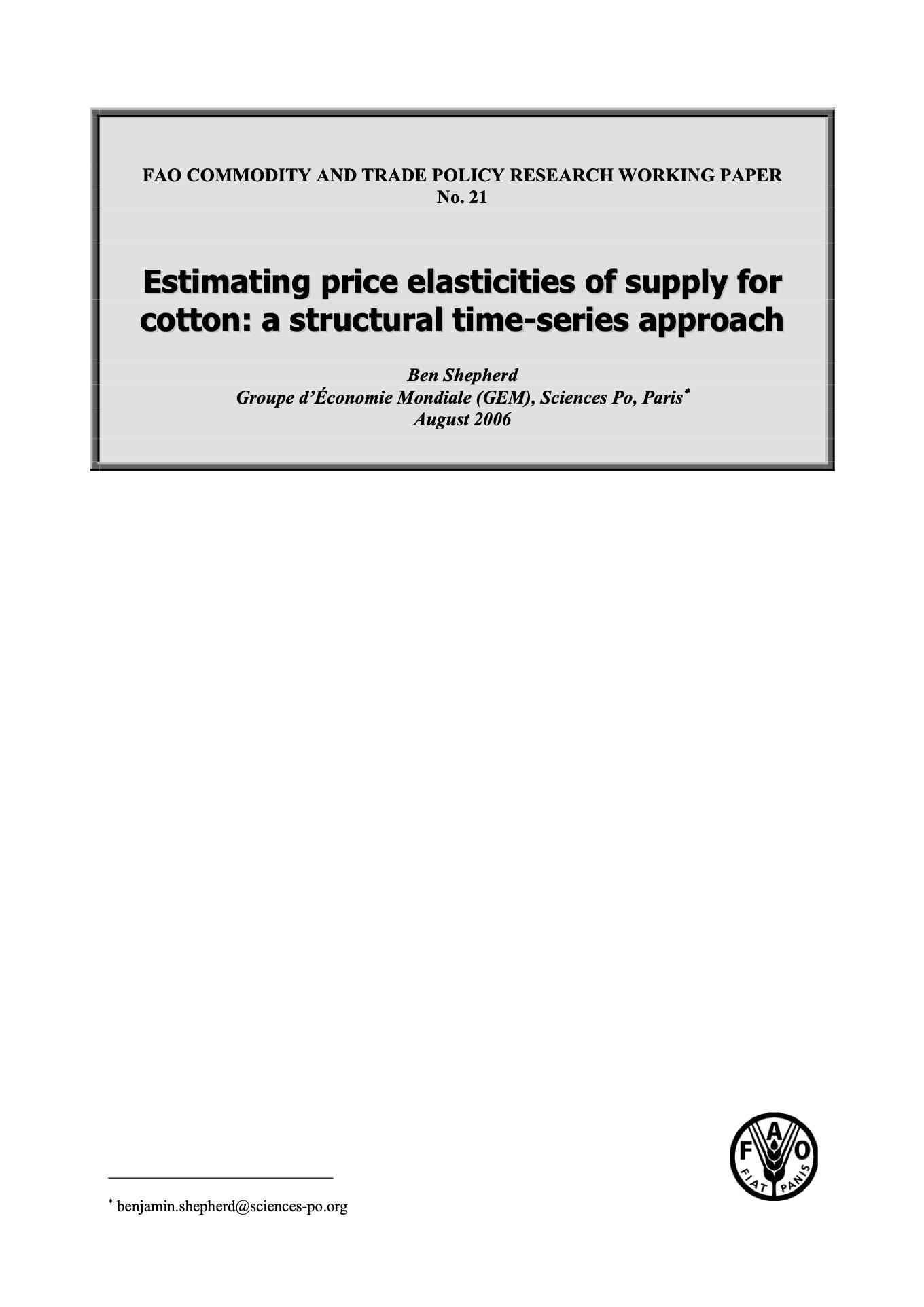
Estimating price elasticities of supply for cotton: a structural time-series approach
01/01/2006
The Kalman Filter is used to estimate a structural time-series model of cotton supply for 30 countries and 16 aggregated regions. Estimated short run supply elasticities with respect to the world price are presented for all 46 countries and regions. While they are broadly within the expected range in light of previous work, they indicate extensive cross-country and regional heterogeneity, as well as considerable parameter uncertainty in some cases. Finally, some proposals are made for incorporating both the core estimates and their sampling distributions into applied equilibrium models.
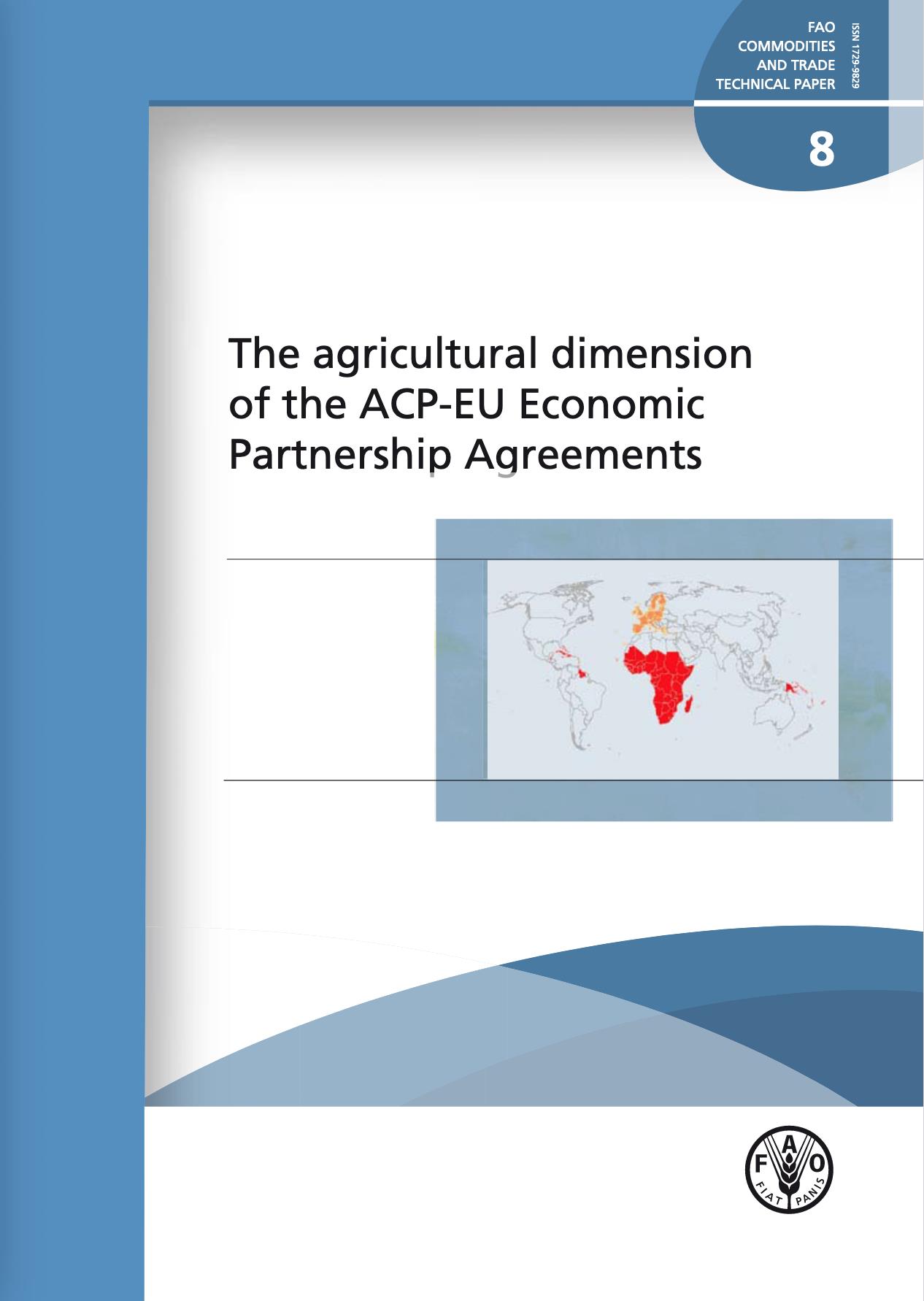
The Agricultural dimension of the ACP-EU Economic Partnership Agreements
01/01/2006
he African Caribbean and Pacific (ACP) countries are facing several major sets of closely interlinked forces that are likely to have significant impact on the development of their agriculture (including fisheries) sectors and their food security situation. The possible conclusion and outcome of both the negotiations for Economic Partnership Agreements (EPAs) under the Cotonou Agreement (with the EU) and the WTO Doha Round pose serious concerns on the future of their agricultural trade and development of the sector. Furthermore, the ongoing CAP reform which will determine the nature of EU agriculture over the next few years, and the process of EU enlargement have also created concerns for ACP States as to how to address these multi-faceted forces so as to reap the maximum benefits for their mostly agrarian economies.
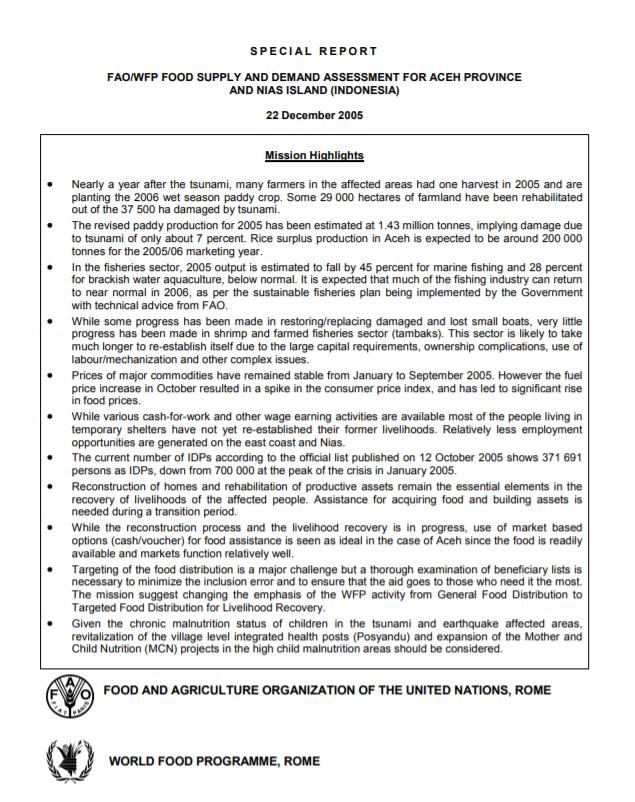
Special Report - FAO/WFP Food Supply and Demand Assessment for Aceh Provind and Nias Island (Indonesia)
22/12/2005
Earlier in the year from 12 to 25 March 2005 FAO and WFP conducted a first assessment of food supply and demand in the tsunami affected districts of Aceh Province. The assessment showed that the livelihoods of approximately 600 000 people had been directly affected by the tsunami of 26 December 2004. At the same time rice production was expected to show some 200,000 tonnes surplus for the 2005/06 marketing year (April/March). At that time the recovery effort by the Government and the international community had just begun. The main objective of this follow-up mission undertaken jointly by FAO and WFP from 7 to 18 November 2005 was, therefore, to determine, after 11 months since tsunami struck, the extent to which people have resumed some form of livelihood which allows them to have sustainable access to markets in order to obtain sufficient and nutritious food. The focus of the Mission was on the extent of agricultural recovery, functioning of markets, and changes in food security, nutrition and vulnerability status of people affected by the tsunami and the role of food aid. The special case of Nias, which was heavily affected by the earthquake on 28 March 2005, is highlighted.
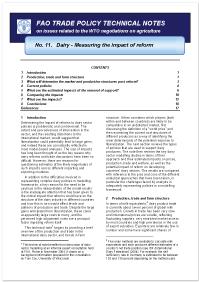
No. 11 Dairy: Measuring the impact of reform
06/12/2005
Determining the impact of reforms to dairy sector policies is problematic and controversial. The extent and pervasiveness of intervention in the sector, and the resulting distortions to the international market, would suggest that liberalization could potentially lead to large gains, and indeed these are consistently reflected in most model-based analyses. The size of impacts has long been thought of as the key reason why dairy reforms and trade discussions have been so difficult. However, there are reasons for questioning estimates of the likely magnitudes of such impacts across different importing and exporting countries.
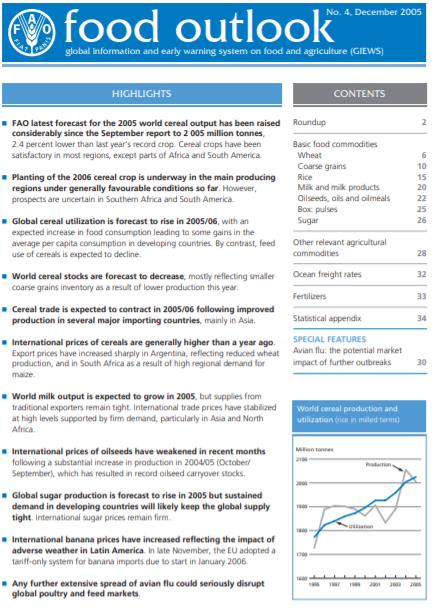
Food Outlook - December 2005
05/12/2005
FAO latest forecast for the 2005 world cereal output has been raised considerably since the September report to 2 005 million tonnes, 2.4 percent lower than last year’s record crop. Cereal crops have been satisfactory in most regions, except parts of Africa and South America. Planting of the 2006 cereal crop is underway in the main producing regions under generally favourable conditions so far. However, prospects are uncertain in Southern Africa and South America. Global cereal utilization is forecast to rise in 2005/06, with an expected increase in food consumption leading to some gains in the average per capita consumption in developing countries. By contrast, feed use of cereals is expected to decline. World cereal stocks are forecast to decrease, mostly reflecting smaller coarse grains inventory as a result of lower production this year. Cereal trade is expected to contract in 2005/06 following improved production in several major importing countries, mainly in Asia. International prices of cereals are generally higher than a year ago. Export prices have increased sharply in Argentina, reflecting reduced wheat production, and in South Africa as a result of high regional demand for maize. World milk output is expected to grow in 2005, but supplies from traditional exporters remain tight. International trade prices have stabilized at high levels supported by firm demand, particularly in Asia and North Africa. International prices of oilseeds have weakened in recent months following a substantial increase in production in 2004/05 (October/September), which has resulted in record oilseed carryover stocks. Global sugar production is forecast to rise in 2005 but sustained demand in developing countries will likely keep the global supply tight. International sugar prices remain firm. International banana prices have increased reflecting the impact of adverse weather in Latin America. In late November, the EU adopted a tariff-only system for banana imports due to start in January 2006. Any further extensive spread of avian flu could seriously disrupt global poultry and feed markets.
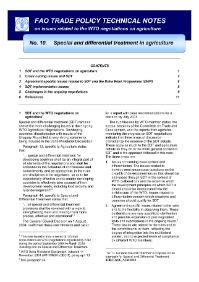
No. 10 Special and differential treatment in agriculture - November 2005
08/11/2005
This technical note is intended to contribute to the process of clarifying issues and identifying possible options to facilitate agreement on areas of special and differential treatment in the context of the agriculture negotiations. It first addresses what is seen by some members as the most difficult area, the cross cutting issues related to development, focused on the principles behind, and purpose of, SDT. It then examines the agreement-specific proposals under the three pillars of the Agreement on Agriculture (AoA), as raised in the August Framework Agreement. It concludes with a discussion of implementation, an area of particular concern to the developing countries.
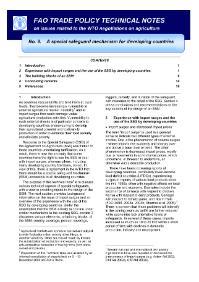
No. 9 A special safeguard mechanism for developing countries - October 2005
04/10/2005
As countries reduce tariffs and bind them at lower levels, they become increasingly vulnerable to external agricultural market instability and to import surges that could damage viable agricultural production activities. Vulnerability to such external shocks is of particular concern to developing countries endeavoring to develop their agricultural potential and to diversify production in order to enhance their food security and alleviate poverty.
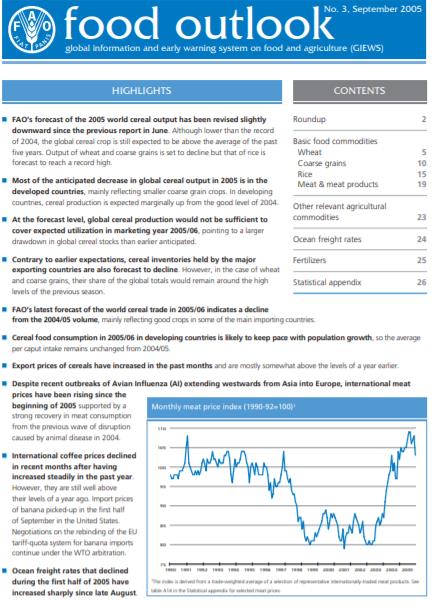
Food Outlook - September 2005
03/10/2005
FAO’s forecast of the 2005 world cereal output has been revised slightly downward since the previous report in June. Although lower than the record of 2004, the global cereal crop is still expected to be above the average of the past five years. Output of wheat and coarse grains is set to decline but that of rice is forecast to reach a record high. Most of the anticipated decrease in global cereal output in 2005 is in the developed countries, mainly reflecting smaller coarse grain crops. In developing countries, cereal production is expected marginally up from the good level of 2004. At the forecast level, global cereal production would not be sufficient to cover expected utilization in marketing year 2005/06, pointing to a larger drawdown in global cereal stocks than earlier anticipated. Contrary to earlier expectations, cereal inventories held by the major exporting countries are also forecast to decline. However, in the case of wheat and coarse grains, their share of the global totals would remain around the high levels of the previous season. FAO’s latest forecast of the world cereal trade in 2005/06 indicates a decline from the 2004/05 volume, mainly reflecting good crops in some of the main importing countries. Cereal food consumption in 2005/06 in developing countries is likely to keep pace with population growth, so the average per caput intake remains unchanged from 2004/05. Export prices of cereals have increased in the past months and are mostly somewhat above the levels of a year earlier. Despite recent outbreaks of Avian Influenza (AI) extending westwards from Asia into Europe, international meat prices have been rising since the beginning of 2005 supported by a strong recovery in meat consumption from the previous wave of disruption caused by animal disease in 2004. International coffee prices declined in recent months after having increased steadily in the past year. However, they are still well above their levels of a year ago. Import prices of banana picked-up in the first half of September in the United States. Negotiations on the rebinding of the EU tariff-quota system for banana imports continue under the WTO arbitration. Ocean freight rates that declined during the first half of 2005 have increased sharply since late August.
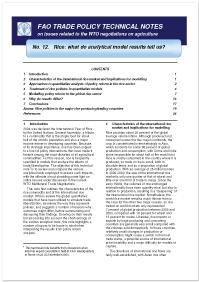
No. 12 Rice: what do analytical model results tell us?
13/09/2005
2004 was declared the International Year of Rice by the United Nations General Assembly, a tribute to a commodity that is the staple food for about half of the world’s population and also a major income earner in developing countries. Because of its strategic importance, rice has been subject to a host of policy interventions that have made it feature among the most distorted of all agricultural commodities. For this reason, rice is frequently specified in models that analyse the effects of trad e liberalization. The objective of this technical note is to review and compare the various analytical tools employed to assess such impacts, with the ultimate aim of shedding some light on critical issues under discussion in the current WTO Multilateral Trade Negotiations.

